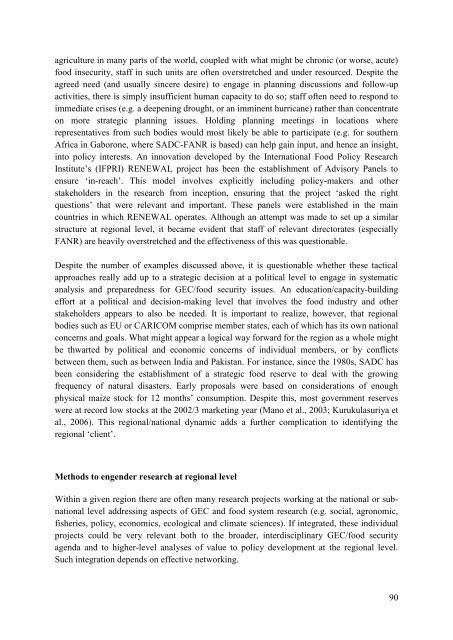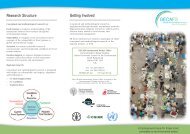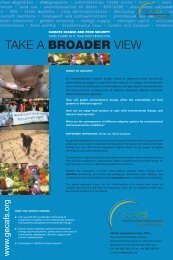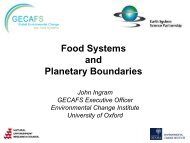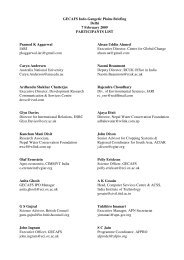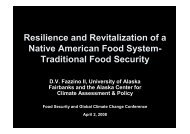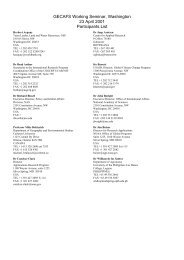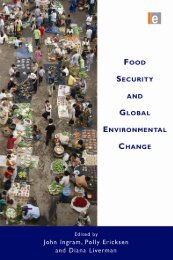From Food Production to Food Security - Global Environmental ...
From Food Production to Food Security - Global Environmental ...
From Food Production to Food Security - Global Environmental ...
- No tags were found...
Create successful ePaper yourself
Turn your PDF publications into a flip-book with our unique Google optimized e-Paper software.
agriculture in many parts of the world, coupled with what might be chronic (or worse, acute)food insecurity, staff in such units are often overstretched and under resourced. Despite theagreed need (and usually sincere desire) <strong>to</strong> engage in planning discussions and follow-upactivities, there is simply insufficient human capacity <strong>to</strong> do so; staff often need <strong>to</strong> respond <strong>to</strong>immediate crises (e.g. a deepening drought, or an imminent hurricane) rather than concentrateon more strategic planning issues. Holding planning meetings in locations whererepresentatives from such bodies would most likely be able <strong>to</strong> participate (e.g. for southernAfrica in Gaborone, where SADC-FANR is based) can help gain input, and hence an insight,in<strong>to</strong> policy interests. An innovation developed by the International <strong>Food</strong> Policy ResearchInstitute’s (IFPRI) RENEWAL project has been the establishment of Advisory Panels <strong>to</strong>ensure ‘in-reach’. This model involves explicitly including policy-makers and otherstakeholders in the research from inception, ensuring that the project ‘asked the rightquestions’ that were relevant and important. These panels were established in the maincountries in which RENEWAL operates. Although an attempt was made <strong>to</strong> set up a similarstructure at regional level, it became evident that staff of relevant direc<strong>to</strong>rates (especiallyFANR) are heavily overstretched and the effectiveness of this was questionable.Despite the number of examples discussed above, it is questionable whether these tacticalapproaches really add up <strong>to</strong> a strategic decision at a political level <strong>to</strong> engage in systematicanalysis and preparedness for GEC/food security issues. An education/capacity-buildingeffort at a political and decision-making level that involves the food industry and otherstakeholders appears <strong>to</strong> also be needed. It is important <strong>to</strong> realize, however, that regionalbodies such as EU or CARICOM comprise member states, each of which has its own nationalconcerns and goals. What might appear a logical way forward for the region as a whole mightbe thwarted by political and economic concerns of individual members, or by conflictsbetween them, such as between India and Pakistan. For instance, since the 1980s, SADC hasbeen considering the establishment of a strategic food reserve <strong>to</strong> deal with the growingfrequency of natural disasters. Early proposals were based on considerations of enoughphysical maize s<strong>to</strong>ck for 12 months’ consumption. Despite this, most government reserveswere at record low s<strong>to</strong>cks at the 2002/3 marketing year (Mano et al., 2003; Kurukulasuriya etal., 2006). This regional/national dynamic adds a further complication <strong>to</strong> identifying theregional ‘client’.Methods <strong>to</strong> engender research at regional levelWithin a given region there are often many research projects working at the national or subnationallevel addressing aspects of GEC and food system research (e.g. social, agronomic,fisheries, policy, economics, ecological and climate sciences). If integrated, these individualprojects could be very relevant both <strong>to</strong> the broader, interdisciplinary GEC/food securityagenda and <strong>to</strong> higher-level analyses of value <strong>to</strong> policy development at the regional level.Such integration depends on effective networking.90


